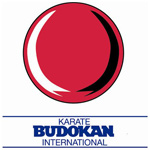Budokan karate
From Wikipedia, the free encyclopedia
Budokan (武道館 Budōkan?) is a style of karate recognized by the World Union of Karate Do Organizations[1] and theWorld Karate Federation. Karate Budokan International was founded on July 17, 1966 by Chew Choo Soot in Petaling Jaya,Malaysia and grew to expand throughout the world.
Contents
[hide]The Founder[edit]
Chew Choo Soot was born in Alor Star, a Northern State of Peninsula, Malaysia, on February 7, 1922. As an infant, his father died and so he was brought up under the strict discipline of his grandfather, an elderly Confucian scholar of the old school of China, who believed in education through books and not in martial arts.
At 15 years of age, Chew became very interested in weight lifting and enrolled for training at a small body building club in Epoh. Due to his dedication and training, he became the national Malaysian weight lifting champion in both the feather weight and the light weight classes in 1939, 1941 and 1942. During those years he also acquired an interest in martial arts and took up judo, jujitsu and wrestling.
It was not until he was 20 that Chew was introduced to Karate-Do, during the Japanese occupation of Malaya. He was then contracted by a Japanese military officer, who had seen him in health and strength magazines, to become a personal fitness and weight lifting coach. During one of his scheduled visits, the young Chew discovered the officer practicing movements which we now know to be karate ‘Kata’. The styles of karate practiced by the officer were Keishinkan andShotokan. Chew was impressed and asked for tuition, which the officer agreed to. For more than 2 years afterwards, they spent the evenings training together in karate, jujitsu, judo and weight lifting until the Japanese Army officer left for Okinawain 1945.
After the end of the Second World War, Chew went to Japan and Okinawa to further his karate training, as well as several trips to Taiwan to learn kung-fu and oriental weapons from a number of old kung-fu Masters of China.
In 1966 at the request of his friends, Chew then decided to start a dojo at Petaling Jaya with a small number of students and Karate Budokan International was first founded as a lesser organisation. There was a large amount of interest shown by people who wanted to learn karate, which became so great that he found it impossible to cope with the classes without seeking assistant instructors. As there were no other karate instructors in Malaysia, he then made two further trips to Tokyoand Osaka and employed 7 Japanese instructors to assist him to conduct the karate classes. These classes had then spread the art to the North and South of the Peninsula within 2 years.
Chew's ambition was to be able to travel to different countries and conduct karate classes when he reached the age of 80. Unfortunately, he fell ill by a paralytic attack on 4 February 1995 and died, in Malaysia, on 18 July 1997 at the age of 76 years.[2][3]
Global Expansion[edit]
Karate Budokan International is now a global association with branches around the world including Australia, India, Israel, Germany, Malaysia, Pakistan, Norway, Sri Lanka, United Arab Emirates, United States of America, Cameroon, Wales and England. The world headquarters for KBI is located in Noosa, Queensland, Australia.
The Grand Master[edit]
Richard Chew, the second son of the Founder Chew Choo Soot, was second Grand Master of Karate Budokan International. He followed the paths of his great father by visiting and conducting training camps and seminars at the Budokan Dojos worldwide and thus makes sure that the Budokan style is practiced in its pure form.
Karate Budokan International's current World Chief Instructor is Wayne Macdonald of the Noosa headquarters. Macdonald started Karate with Sensei Daniel Spice (from the NSW branch through HMAKarate ) on the same day in 1979. As cousins, they went together to their first karate class for mutual support, although Macdonald often recalls the situation differently. He recalls that Spice was too scared to go to karate by himself, so Macdonald went along to ‘hold his hand’.[4]
Wayne’s training has been under the guidance of the KBI Grand Master Richard Chew and Fabio Martella, and Wayne has been teaching Karate since 1983. Wayne and his wife Donna, now run a dojo (and International Headquarters) inNoosaville with over 400 members.
Macdonald has also been highly respected over the last two decades as one of Australia’s elite Karate athletes with six New South Wales titles (1986,87,88,89,90,91), two Queensland titles (1998 and 99) as well as 5 National titles.[5]
In the Asian Countries, the Budokan Karate is continuing to grow under the able leadership of B. Parmesh of India.
All India Budokan Karate Federation formed in India in 1991 by late Grand Master Mr. Chew Choo Soot: he appointed Mr. C. Hanumantha Rao as President, Mr. Syed Ahmed as Secretary General; now AIBKF is the largest and strongest karate organisation in India.
See also[edit]
References[edit]
External links[edit]
| ||||||||||||||||||||||||||||||||||||||





